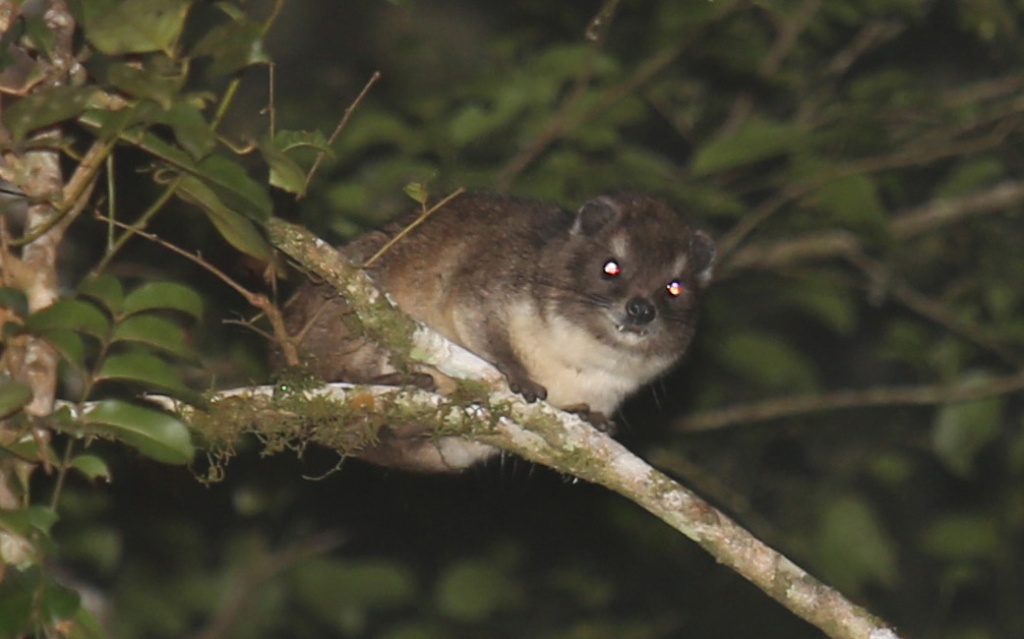by HANNA ROSTI
Published in Scientific Reports 16.4.2022 https://www-nature-com.libproxy.helsinki.fi/articles/s41598-022-10235-7
Highlights of the article
- Names of trees and woody climbers tree hyraxes are using in Taita Hills.
- Woody climbers are very important for tree hyraxes as shelter, climbing and food.
- Tree hyraxes needs larger forests, that are more than 90 ha in size
- Tree hyraxes prefer tall trees with dense canopy coverage
- Tree hyrax singing frequency reduces significantly as size of the forest decreases
- Tree hyraxes are social, not solitary as previously believed
- Tree hyrax conservation is urgently needed
1. Trees and woody climbers tree hyraxes are using in Taita Hills, Kenya. Meaning of woody climbers.
Most important trees for tree hyraxes are Macaranga capensis, Tabernaemontana stapfiana, Albizia gumnifera, Strombozia scheffleri, Syzygium cordatum, Celtis africana, Vitex keniensis, Milletia oblata, Pouteria adolf-friedericii and Newtonia buchananii.
Woody climbers are very important for tree hyraxes! In Taita Hills, tree hyraxes feed often on Dichapetalum eichii. Woody climbers are used by tree hyraxes for moving between and on the trees, and for resting. Woody climbers form tight nets around the trunks of the trees that may have width of several meters. In these tangled nets tree hyraxes may rest during the days and nights. They may form cave like formations, where tree hyraxes are completely safe and only slightly visible to thermal imaging camera.
This information can be used for conservation and reforestation purposes. When planting new trees, these indigenous trees are important for tree hyraxes – and to other animals as well. Conservation of woody climbers is very important for tree hyraxes as well. Previously tree hyraxes were thought to be dependent on cavities in trees, but our research with thermal imaging camera showed that woody climbers are just as important.

Tree hyrax population size in Taita Hills
Tree hyraxes are most common in the largest forests of Taita Hills. Our analysis of calling rate / hour showed that as the size of the forest decreases, calling rate crashes. In forests less than 90 ha, tree hyraxes call rarely and they time their calls to the time when humans are not around, about 03 or 04 am.
This most likely indicates that in smaller forest, tree hyraxes have been poached close to the local extinction.
Tree hyraxes are isolated to their forests, outside forests in tiny patches of indigenous trees, there are some tree hyraxes. These populations are living in constant danger of human harassment and on the ground dogs will kill them fast.

3. Tree hyraxes prefer tall trees and dense canopy coverage
From airborne lidar, several characteristics from the forests were measured. In the analysis we used height of the forest and canopy coverage. Both had positive effect on tree hyraxes.
Highest calling rates were measured from locations were tree height was over 45 meters and where canopy coverage was dense. In these tall trees, often Pauterias, tree hyrax communities flourish.
4. Singing of tree hyraxes is most common in the most pristine indigenous forest
In the best locations, tree hyraxes sang during the study in more than 20 % of the hours. This means that on average, about two hours contained singing in good quality locations.
Tree hyrax songs can be long, and they have several different syllables that they may combine in different order.
In smaller forest, tree hyraxes were recorded singing only once.
This means that in the disturbed forests, natural behavior of tree hyraxes is disturbed also. This may be due to reduced population size or/and stress that individuals are experiencing in smaller fragments, with possibly higher possibility of getting poached.
Poaching of tree hyraxes still happens in Taita Hills. All thought it is not common. However tree hyraxes are slow reproducers, with just one or two offspring / year.

5. Tree hyraxes are social animals
Previously tree hyraxes were thought to be solitary animals, and their calling was believed to be territorial.
Our research with thermal imaging camera clearly showed that tree hyraxes live in groups.
These groups have guards, and these guards call when someone or something comes to their area.
We observed again and again how some animals are calling on guard, and some animals just nearby keep feeding or resting.
We also observed several animals together multiple times.
It actually makes more sense that tree hyraxes have similar kind of social organization as their relatives rock hyraxes and bush hyraxes.

6. Tree hyrax conservation is urgently needed, for them, but also for the sake of people and other species
Tree hyraxes are browsers, and they don’t cause any disturbance to people. They only eat leaves from indigenous trees.
Tree hyraxes and all other forms of life in Taita Hills would benefit enormously if forest cover in Taita Hills would increase.
This increase in forest cover is needed for survival of the remaining forests, as they are drying out in the lack of water. These forests are home to thousands of species.
Indigenous forests have a very strong pull for water, and increase of forest cover would increase rainfall in the area.
Deforestation has caused severe lack of water in Taita Hills and surrounding lowlands. Rivers are drying out and farming is becoming very difficult.
Tree hyraxes are isolated to their small forest patches, and without reforestation their survival is in danger.

Leave a comment